In photography, ISO is defined as the sensitivity of physical film, or the signal gain of a digital camera’s sensor.
As ISO increases, such as from ISO 100 to ISO 800, your photo will become brighter due to the extra light sensitivity of your film or camera sensor, but at the expense of increased grain or digital noise, which often degrades your image.
ISO is one of the three parts of the exposure triangle that controls the exposure of an image, with camera shutter speed and lens aperture making up the other two sides of the triangle.
To get a correctly exposed image, you must balance shutter speed, aperture and ISO. Changing any one of these means that you must make a corresponding change to at least one of the other elements in order to keep the image properly exposed.
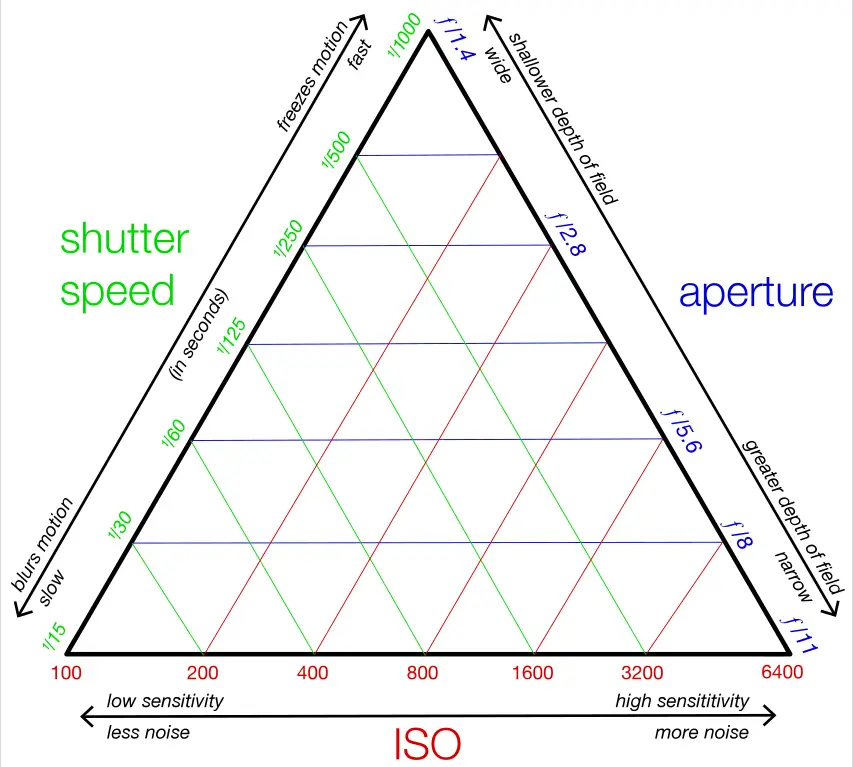
What Does ISO Stand for in Photography?
ISO in photography stands for your camera’s sensitivity to light, both for digital and film cameras, and is shown in number form, like ISO 64, ISO 100 or ISO 200. The higher the number, the more sensitive your camera is to light, so that photos taken at the same shutter speed and aperture will appear brighter.
You can increase ISO in dark rooms and shooting at night in order to get properly exposed images. The downside to this is that the higher the ISO, the more noise your photo will show.
If you look at the examples below, you can see that as ISO increases, noise increases, particularly in the dark sand dune in the foreground. You can also see that a lower ISO means that you can use a slower shutter speed for the same exposure, in this case generating star trails.
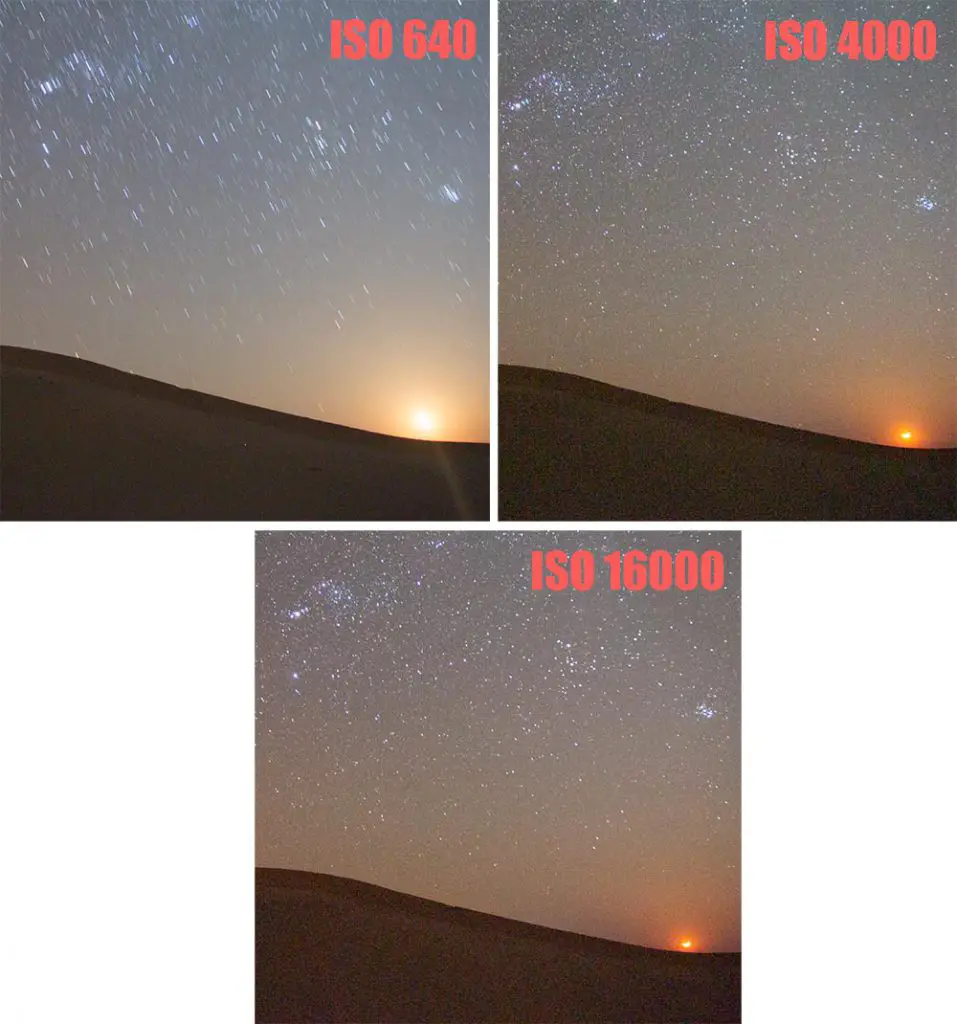
Does Higher ISO Mean More Grain?
Yes, higher ISO does mean more grain or digital noise, as it effectively boosts the exposure of your image, which will make grain, which is normally hard to see, much more prominent.
See the image below for an example of higher ISO meaning more grain in this 100% crop of a photo taken at ISO 6400 on a Canon 6D. You can see much more grain in what would be the shadow areas, had this photo been properly exposed.
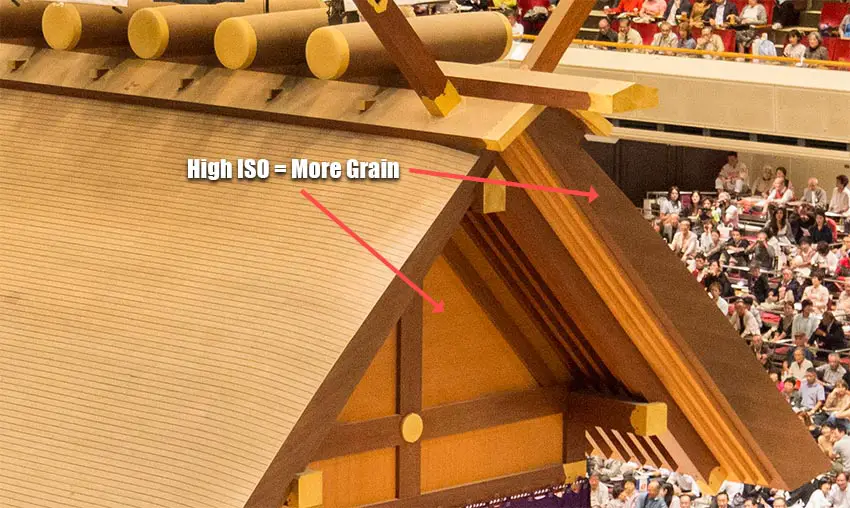
Is ISO 800 Too High?
ISO 800 is not too high for most modern digital cameras, as their sensors do not produce much noise, even at a high ISO.
ISO 800 is considered by most people to be the start of the range where your camera is highly sensitive to light, meaning that it is a good ISO to use when shooting at night, or in dark places.
If you are taking photos in daylight, then ISO 800 is too high, as it will introduce more noise and over-exposed images than a lower ISO. In daytime, you should therefore aim for an ISO in the range of ISO 100 – 200.
Is ISO 3200 Too High?
Yes, ISO 3200 is too high for most cameras, as it causes a larger amount of noise which will degrade your photos. But modern cameras (made since 2018) are able to handle ISO 3200 much better than older cameras, producing less noise overall. Although you should still try to avoid this high ISO, you can still get usable photos, even at ISO 3200, with a modern camera and good photo technique.
What ISO is Too Grainy?
Anything above ISO 1600 is considered too grainy by most people. If you want to avoid grain in your images, then the lowest ISO that you can choose will be best, but generally ISO’s in the range of 100 – 400 will show minimal grain.
What Should ISO be at Night?
It is impossible to give a definitive answer to what your ISO should be at night, but in general, you should aim for the lowest ISO possible that still allows for a properly exposed image, while avoiding too slow of a shutter speed.
Ideally, your ISO at night should in the range of ISO 800 – 1600, with the aperture of your lens wide open at f/2.8 – 4. This should result in the minimum of noise, without causing any blur from camera shake.
Read More:
Is 400 ISO Good for Night?
400 ISO is excellent for night photography if you can get a wide enough aperture to avoid camera shake caused by a too slow shutter speed. ISO 400 will lead to reduced noise, with the general advice being that you should try to reduce noise as much as possible. The lowest ISO that you can get away with will give you the lowest amount of noise.
Can You Shoot 400 ISO at Night?
You can shoot 400 ISO at night, provided that you use a lens with a wide (at least f/2.8) aperture. A wide aperture means that more light gets to your camera film or sensor, and therefore you do not need the sensitivity of a high ISO in order to get a properly exposed image.
Read More:
What is the Best ISO Setting for Portraits?
The best ISO setting for portraits is in the range of ISO 100 to 400, as this provides for a high quality image with low noise, but also lets you deal with the lack of good lighting that you often find when taking portraits indoors.
Portrait photos look better when shot at a wide open aperture with a shallow depth of field like f/1.8 – 2.8. If you lens supports this aperture, then you can reduce your ISO still further, and may be able to keep it around ISO 50 to 100, which will reduce camera sensor noise even more.
What ISO Should I Use for Low Light?
In low light photography, you first want to shoot at as wide an aperture as your lens will allow, in order to get as much light as possible to your camera sensor. If you put your camera on Aperture Priority mode, then it will automatically select the lowest ISO to get a properly exposed picture, with a shutter speed that you can safely shoot at without causing camera shake.
The ideal low light ISO is in the range of 100 – 400, but you can often go up to ISO 800 without any real problem, particularly with modern camera sensors.
What is the Downside of High ISO in Photography?
The downside of high ISO in photography is that you get a lot of grain or digital sensor noise, which affects sharpness of your photos and degrades picture quality. Photos taken at high ISO are noticeably lower in quality when printed at a large size, although you can often get away with more noise if your photos are printed at around 6×4-inches in size.
Is ISO 64 better than 100?
In terms of sensor noise, ISO 64 is better than 100, although ISO 100 has about three-quarters of a stop greater light sensitivity than ISO 64.
This means that ISO 100 is better in lower light situations, but at the expense of slightly more noise, primarily in the shadows, although you are going to be very hard pressed to see the difference in practice.
Although you would be better to use ISO 64 if you can, ISO 100 still delivers excellent quality images on all modern cameras, and gives you greater scope to use a narrower aperture or slower shutter speeds for more creative photography.
What is the Difference Between 100 ISO and 400 ISO?
The difference between 100 ISO and 400 ISO is about two stops of light sensitivity, with 400 ISO being more light sensitive, but at the cost of increased noise and grain.
The extra two stops of light sensitivity in ISO 400 can be very useful in night photography and low light situations, although it is generally not needed in daylight, where the lower noise ISO 100 is preferred.
Is 200 or 400 Film Better?
In low light environments, 400 film is better as it has one extra stop of light sensitivity over 200 film, although it will show more grain.
If you are shooting in normal daylight conditions, then 200 ISO film is better, as it will allow you to use wider apertures, and will not show the same level of grain, which degrades image quality and sharpness.
What Happens If You Shoot 200 ISO Film at 400 ISO?
If you shoot 200 ISO film at 400 ISO, then photos will be overexposed by one stop. This means that highlights can be blown out and not show any detail, but also that shadows are rendered with more detail. This can be a useful creative technique, and for shooting in dark places where you otherwise might find it hard to get a properly exposed image.
Does ISO Matter When Shooting RAW?
ISO does matter when shooting RAW, as ISO is applied to the image data as it leaves the camera sensor, amplifying it before the data is saved to the RAW file. This means that any noise created by using a high ISO will also be saved to your RAW photo, and cannot easily be removed.
Therefore, you should attempt to shoot at low ISO’s in most situations, so that your RAW has limited noise.
Can I Change ISO in RAW?
You cannot directly change ISO in RAW, although you can effectively control how bright each pixel displays by using the Exposure sliders in Camera RAW or Lightroom. This has the effect of brightening your image, but will not create noise in the same way that using high ISO in-camera would.
The disadvantage of using the Exposure sliders over high ISO in-camera, is that you cannot recover the same level of detail in shadow areas, but you should be left with less noise overall.
Read More:
Inspirational quotes about black and white photos
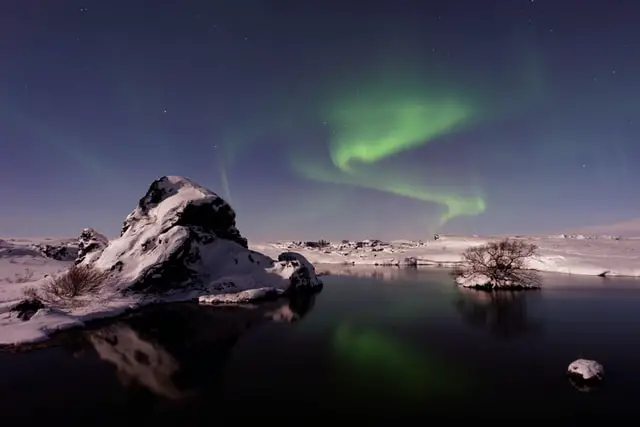
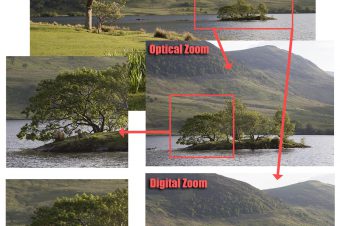

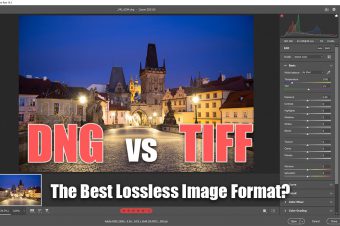
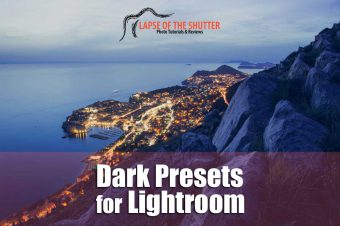
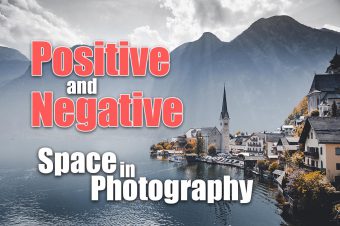
Leave a Reply